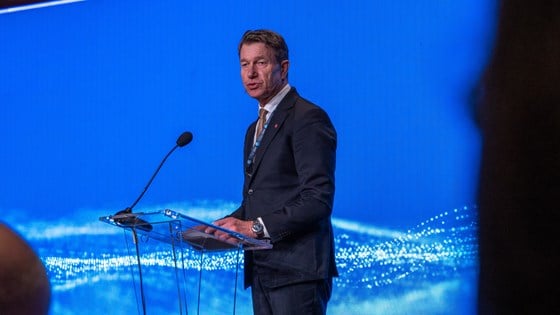Oslo Energy Forum
Speech/statement | Date: 15/02/2024 | Ministry of Energy
Olje- og energiminister Terje Aasland holdt dette innlegget på Oslo Energy Forum, den 15. februar 2024.

Ladies and gentlemen,
What a great pleasure it is to take part in Oslo Energy Forum,
with dear colleagues from the UK and Germany – Norway’s closest energy partners.
We border the North Sea and share the vast resources this sea offers.
And we share the challenges:
- How to provide energy security to a growing world population.
- How to do so in a sustainable manner.
- While securing affordable energy to all, industrial investments and job creation.
How do we solve these tasks at hand?
I believe many of the solutions are found in the North Sea and its surrounding region.
The North Sea is not just a mass of water. It is a symbol of our collective ability to reshape our energy landscape.
The North Sea and the Norwegian continental shelf have been and will still be important providers of oil and gas with low to zero emissions. This will still be necessary in many years to come, because we need energy security, safe jobs and affordable energy.
We will continue to be a stable and predictable supplier of energy to Europe.
In the coming years the North Sea could become an even more important energy hub for Europe. The potential is huge.
Together with the other countries in the North Sea region, our combined plans are to establish 300 GW offshore wind. This will give us many positive ripple effects. Safe, green jobs is one thing of course.
But we will also develop a common North Sea grid that will strengthen our energy systems and provide us with more clean energy that we need to realize the opportunities throughout our countries.
The Norwegian government has high ambitions and a long-term commitment for the development of offshore wind.
Our aim is to award areas for 30 gigawatts by 2040. The first project areas will be awarded this year. We plan to tender the next round of new areas in 2025 and to follow up with new areas regularly.
We look at floating wind with special interest. Our industry can deliver solutions for this technology, building on years of experience from the petroleum industry.
And we believe floating wind will play an important role, not just in Norway, but across Europe and the world.
Carbon management is also a key priority. CCS represent an important pathway to achieve climate neutrality.
And we have much to be proud of.
The goal with our Longship project – which is the largest climate project in Norwegian industry ever – is to build a viable value chain for carbon capture, transport and storage.
We have an important test center for capture technologies at Mongstad, and next year Heidelberg industries will start to produce cement produced with CO2 capture as a result of the Longship project.
We have 27 years of experience in safe and permanent storage in the Norwegian continental shelf. And we have enormous capacity for storage.
Some numbers:
The Net-Zero Industry Act aims to establish storage capacity for fifty million tons of CO2 by 2030 in the EU.
In Norway, we are able to match this number already in the early 2030s alone.
Equinor is leading the development of a CO2 pipeline from Belgium to Norway called the CO2 highway, that could be in operation by 2030. The pipeline alone could transport thirty million tons of CO2 annually.
By now I have awarded licenses to eleven different companies for storage capacity for forty million tons of CO2 per year, and we experience high demand for storage licenses.
We currently experience a strong momentum for carbon management globally, which is a very good thing.
We need and welcome more countries and companies to invest in CCS. This is necessary for CCS to reach economies of scale and help mitigate climate change in a cost-effective way.
Norway also wants to contribute to a market for hydrogen produced with low or zero emissions.
We need hydrogen to achieve our common climate objectives, particularly in hard-to-abate sectors where electrification is not an option. To achieve this, we must reduce costs, minimize energy losses, and explore new applications.
Our view is that blue hydrogen will be necessary in the first phases of a hydrogen market. In the longer term, more renewable power can set the stage for an increasing production of green hydrogen.
A recent study has shown that it is technically possible to establish a pipeline for transporting large quantities of low carbon hydrogen from Norway to Germany.
I am eager to see how the industry will develop this project further.
Dear friends.
Climate goals, energy security, lowering emissions, securing investments and creating jobs.
These goals are all connected. And we are connected.
By the North Sea, through energy, and through our future challenges.
By harnessing the limitless power of this sea, we can power Europe green.
We will continue to build on our strong relationship and cooperation across what is not only an ocean, but a bridge.
Thank you!